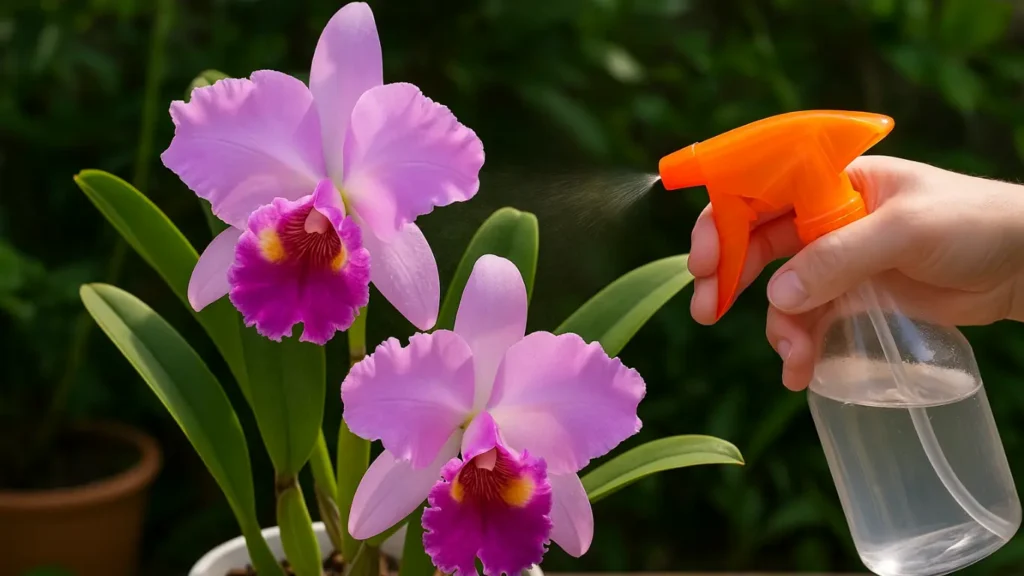
Cattleya orchids, revered as the ‘Queen of Orchids’ for their spectacular, often fragrant blooms, can be incredibly rewarding to grow. This definitive guide demystifies cattleya orchids care, providing expert insights into everything from light and watering to repotting and triggering those magnificent flowers, empowering both novice and seasoned growers to master how to grow cattleya orchids successfully.
Table of Contents
Cattleya Orchid Care at a Glance: Key to Success
Understanding the essential requirements for your cattleya orchid ensures blooming success and healthy growth year after year.
Quick Care Essentials:
- Light: Bright, indirect light is crucial (east or shaded south/west window). Leaves should be medium olive-green
- Watering: Water thoroughly when potting mix is almost dry. Allow good drainage; avoid “wet feet”
- Potting Media: Coarse, open, fast-draining mix (fir bark, charcoal, perlite)
- Temperature: Intermediate to warm (Day: 70-85°F / 21-29°C; Night: 55-65°F / 13-18°C). Night temperature drop beneficial
- Humidity: 50-70% preferred. Use trays, humidifiers, or misting
- Fertilizing: Regular feeding during active growth with balanced orchid fertilizer. Reduce in winter
- Repotting: Every 2-3 years or when media breaks down, typically after flowering when new roots appear
The Allure of Cattleyas: An Introduction to the Queen of Orchids
The cattleya orchid stands as perhaps the most iconic orchid genus, captivating growers worldwide with their extraordinary beauty and relatively straightforward care requirements when properly understood.
What Makes a Cattleya a Cattleya?
Cattleyas possess distinctive botanical characteristics that set them apart from other orchid genera:
Pseudobulbs: These thickened stems serve as water and nutrient storage organs, allowing the plant to survive periods of drought in their natural habitat. Each pseudobulb typically produces one to three leaves and eventually a flower spike.
Flower Structure: The classic cattleya flower features three sepals, three petals (with one modified into the distinctive labellum or “lip”), and a column containing both male and female reproductive parts. The labellum often displays vibrant colors and intricate patterns that serve as landing platforms for pollinators.
Growth Pattern: Cattleyas exhibit sympodial growth, meaning new growths emerge from the base of previous pseudobulbs, creating a chain-like pattern over time.
Origins & Natural Habitat
Native to Central and South America, from Mexico down to Argentina, cattleyas naturally grow as epiphytes in tropical forests. This epiphytic lifestyle means they anchor themselves to tree branches and rocks, deriving nutrients from rain, debris, and air rather than soil.
Understanding this natural habitat is crucial for successful cattleya orchids care. In the wild, their roots are exposed to excellent air circulation and experience cycles of moisture followed by drying periods. This natural pattern directly influences how we should care for them in cultivation.
The Main Groups of Cattleyas
Unifoliate Cattleyas: These produce one leaf per pseudobulb and typically showcase larger, more spectacular flowers. Classic examples include Cattleya labiata (the type species) and Cattleya mossiae. These varieties often require a distinct dry rest period to initiate blooming.
Bifoliate Cattleyas: Producing two or more leaves per pseudobulb, these cattleyas often feature smaller but more numerous, waxy flowers. Species like Cattleya aclandiae and Cattleya walkeriana fall into this category. They tend to be more compact and may have slightly different temperature preferences.
Intergeneric Hybrids: Modern horticulture has created stunning crosses between cattleyas and related genera, resulting in names like Brassocattleya (Bc.), Laeliocattleya (Lc.), and Sophrolaeliocattleya (Slc.). While care remains similar to pure cattleyas, these hybrids may inherit traits from their other parent genera.
Perfecting Cattleya Orchid Care: The In-Depth Grower’s Guide
Mastering how to grow cattleya orchids requires attention to several critical environmental factors. Each element works synergistically to create optimal growing conditions.
Light: The Most Critical Factor for Cattleya Blooming
Proper lighting makes the difference between a thriving, blooming cattleya and a struggling plant that never flowers.
Understanding “Bright, Indirect Light”: Cattleyas need approximately 2,000-3,000 foot-candles of light—bright enough to read comfortably but not harsh direct sunlight. The ideal leaf color should be medium olive-green. Dark green leaves indicate insufficient light, while yellowish or reddish leaves suggest too much direct sun.
Window Placement Strategies:
- East windows: Provide gentle morning sun—ideal for most cattleyas
- South/West windows: Require sheer curtains or placement 2-3 feet away from the glass
- North windows: Generally insufficient unless supplemented with grow lights
Grow Light Options: LED grow lights designed for orchids work excellently, positioned 12-18 inches above plants and operated 12-14 hours daily during growing season.
Light Troubleshooting:
- Too much light: Leaves develop brown spots, turn reddish, or appear scorched
- Too little light: Leaves become dark green, pseudobulbs elongate, and flowering ceases
Watering Wisdom: The Art of Hydrating Epiphytic Roots
Proper watering technique is essential for healthy root development and overall plant vigor.
When to Water: The “almost dry” rule works best—water when the potting medium is nearly dry but not completely desiccated. Test by:
- Weight method: Lift the pot; it should feel noticeably lighter
- Skewer test: Insert a wooden skewer into the medium; it should come out barely moist
- Finger test: Push your finger 1-2 inches into the medium
How to Water: Water thoroughly until it flows freely from drainage holes. This flushes accumulated salts and ensures complete hydration. Avoid getting water in new growths or leaf joints, as this can cause rot.
Water Quality Considerations:
- Best options: Rainwater, reverse osmosis, or distilled water
- Tap water: Acceptable if not heavily chlorinated or very hard
- Temperature: Use lukewarm water to avoid shocking the roots

The Ideal Potting Media & Potting Techniques for Cattleyas
The right potting medium ensures proper drainage while providing stability and some moisture retention.
Essential Media Characteristics: Cattleya potting mixes must be coarse, chunky, and fast-draining. Popular combinations include:
| Component | Purpose | Ratio |
|---|---|---|
| Fir bark (medium grade) | Primary drainage, structure | 60-70% |
| Perlite | Additional drainage, aeration | 15-20% |
| Charcoal | Toxin absorption, longevity | 10-15% |
| Sphagnum moss | Moisture retention | 5-10% |
Pot Selection:
- Clay pots: Provide excellent drainage and air circulation to roots
- Plastic pots: Retain moisture longer; good for drier environments
- Size: Choose pots that accommodate 2-3 years of growth without being oversized
Mounting Alternative: Advanced growers often mount cattleyas on tree fern or cork bark, mimicking their natural epiphytic habitat completely.
Temperature & Airflow: Mimicking Their Native Environment
Temperature management directly affects growth patterns and flowering cycles.
Optimal Temperature Ranges:
- Daytime: 70-85°F (21-29°C)
- Nighttime: 55-65°F (13-18°C)
- Temperature drop: A 10-15°F nighttime reduction often triggers flowering in many species
Air Circulation Requirements: Gentle, constant air movement prevents fungal issues and strengthens plant tissues. A small fan running continuously works well, but avoid direct drafts.
Seasonal Considerations: Many cattleyas benefit from slightly cooler, drier conditions during winter months, mimicking their natural dry season.
Humidity Hacks: Creating the Perfect Microclimate
Maintaining 50-70% humidity around your cattleya orchid promotes healthy growth and flowering.
Effective Humidity Methods:
- Humidity trays: Place pots on trays filled with wet pebbles or expanded clay pellets
- Room humidifiers: Ultrasonic humidifiers work well for multiple plants
- Grouping plants: Creates beneficial microclimates through transpiration
- Misting: Light misting of air around plants (not leaves) during morning hours
Monitoring Humidity: Digital hygrometers help track humidity levels accurately. Place them at plant level for best readings.
Fertilizing for Optimal Growth and Blooming
Regular feeding during the active growing season supports robust growth and flower production.
Fertilizer Schedule:
- Growing season: Weekly feeding with diluted orchid fertilizer
- Winter: Monthly feeding or complete rest, depending on species
- Concentration: “Weakly weekly” approach—quarter to half-strength solutions
Best Fertilizer Types: Balanced orchid fertilizers (20-20-20 or similar) work well for most situations. Some growers alternate between high-nitrogen (30-10-10) during growth and high-phosphorus (10-30-20) before flowering.
Repotting: Timing and Technique
Repotting every 2-3 years maintains healthy root systems and prevents media breakdown.
When to Repot:
- Potting medium breaks down and becomes soggy
- Roots overflow the pot significantly
- After flowering when new root growth begins
- When plants show signs of stress despite proper care
Repotting Steps:
- Remove old medium completely
- Trim dead or rotted roots with sterile tools
- Select appropriate pot size
- Position plant with newest growth toward pot center
- Fill with fresh medium, ensuring good contact with roots
- Water lightly and place in bright, indirect light
Troubleshooting Common Issues
No blooms: Usually indicates insufficient light or lack of temperature differential Yellow leaves: Natural aging of older leaves or overwatering Black spots: Often fungal issues from poor air circulation or excessive moisture Wrinkled pseudobulbs: Typically underwatering or root problems
Seasonal Care Calendar
Spring: Resume regular watering and fertilizing as new growth emerges Summer: Peak growing season with consistent care and monitoring Fall: Reduce fertilizing as growth slows, maintain consistent watering Winter: Many species benefit from reduced watering and fertilizing
Conclusion
Mastering cattleya orchids care requires understanding their epiphytic nature and providing conditions that mimic their natural habitat. With proper light, watering, and environmental conditions, these magnificent orchids will reward you with spectacular blooms that truly earn them the title “Queen of Orchids.”
Success with cattleyas comes from consistent care rather than complex techniques. By following these guidelines and observing your plants’ responses, you’ll develop the intuition needed to grow healthy, blooming cattleya orchids for years to come.
Remember, each cattleya has its own personality and may require slight adjustments to these general guidelines. The key is patient observation and gradual refinement of your care routine to match your specific growing conditions and plant needs.
Author
George Wine is a seasoned gardening expert with over 20 years of experience in the field of horticulture. His passion for plants and nature has driven his career, where he has honed his skills in various aspects of gardening, from landscape design to plant care. George holds a Master of Science in Horticulture from the University of California, Davis (UC Davis), a prestigious institution known for its research and advancements in plant science.
Throughout his career, George has worked with a diverse range of clients, offering tailored solutions to enhance outdoor spaces and create thriving gardens. His knowledge and expertise allow him to provide invaluable advice, ensuring that both novice and experienced gardeners achieve their gardening goals. Whether you’re looking for tips on sustainable gardening practices, innovative design ideas, or advice on specific plant species, George is here to help you cultivate the garden of your dreams.






